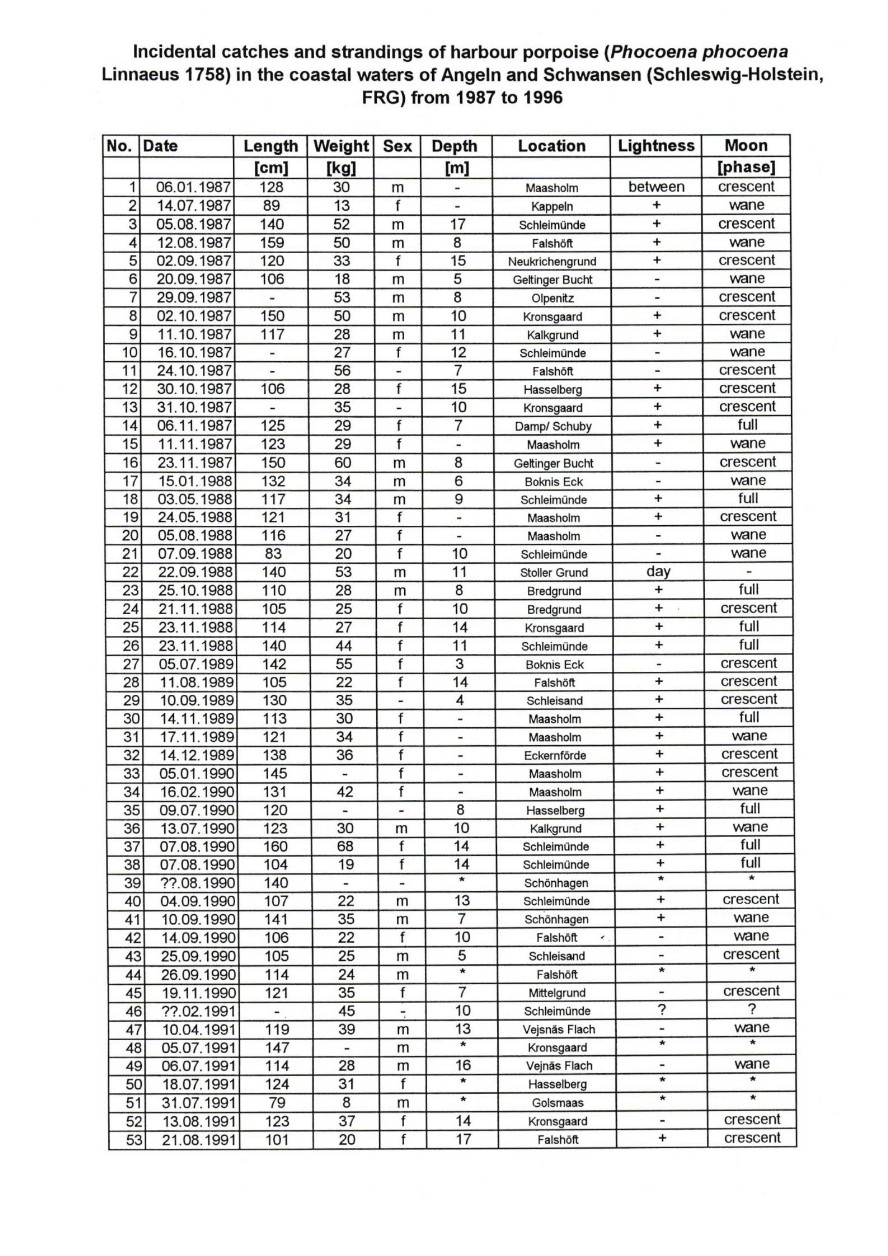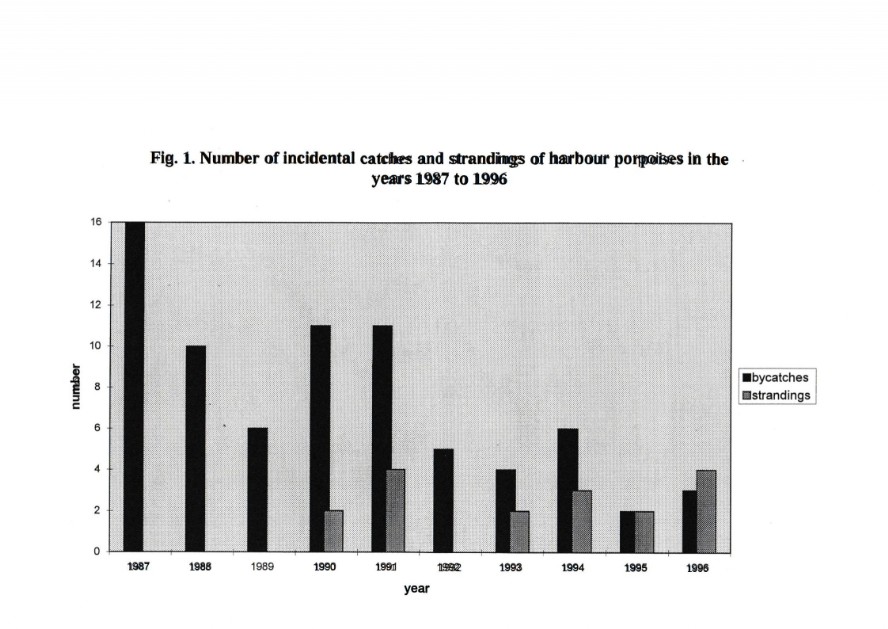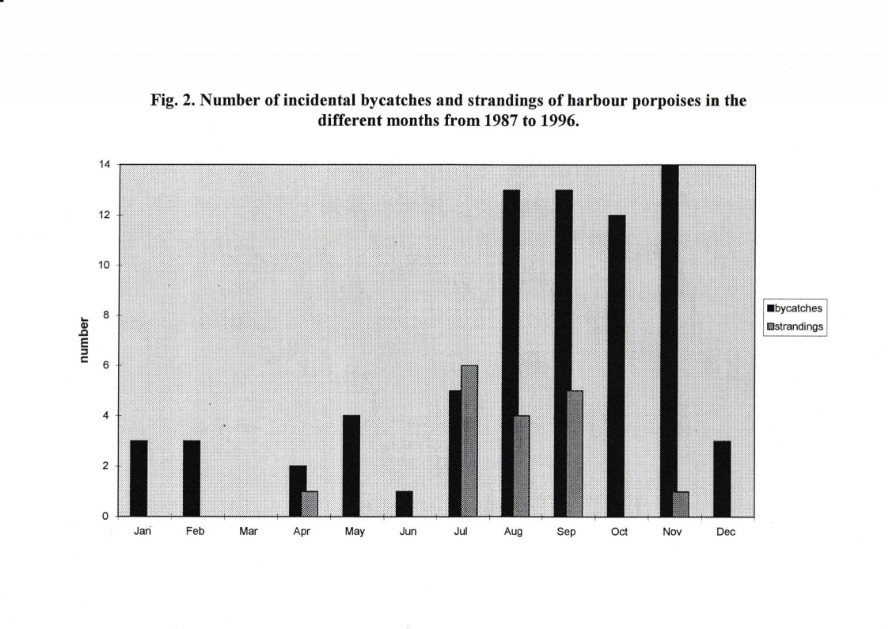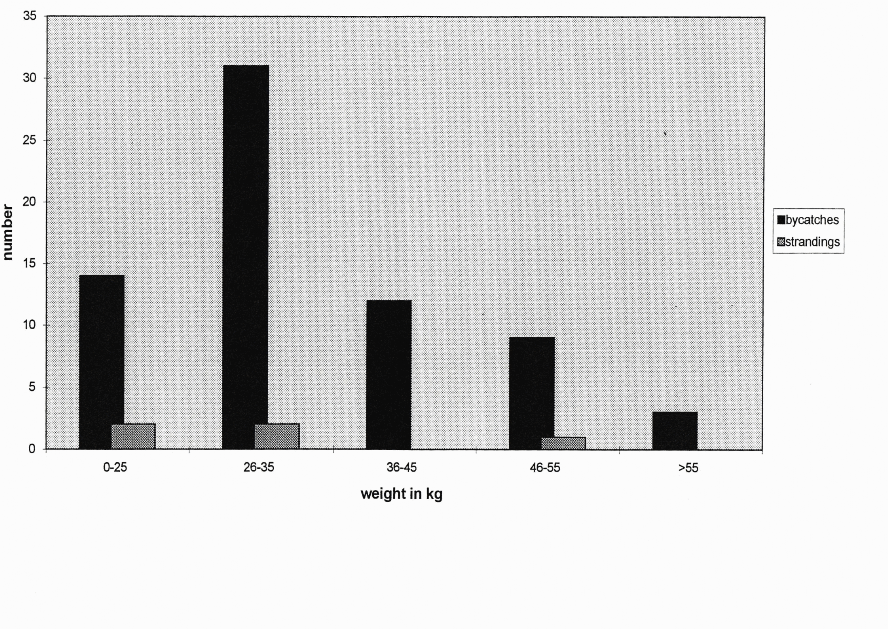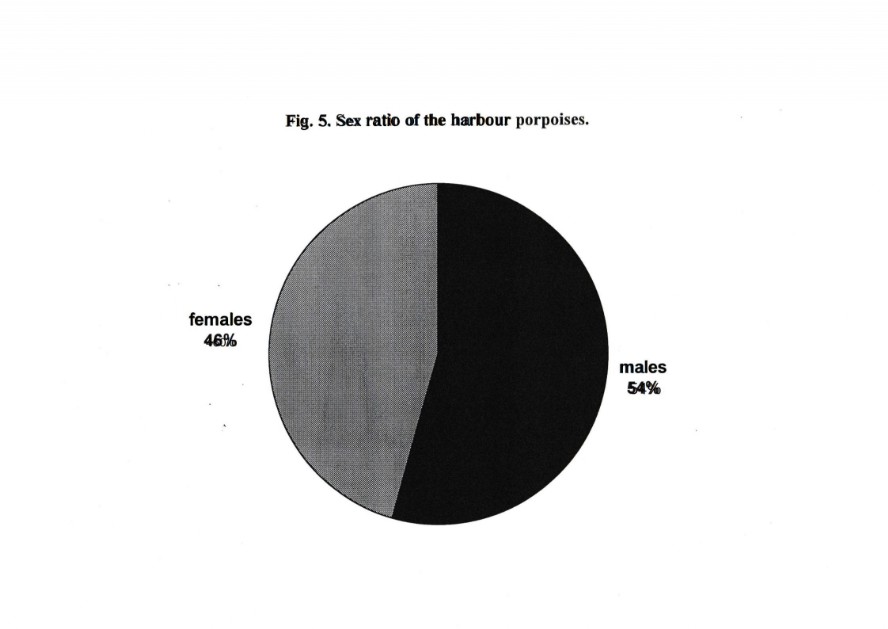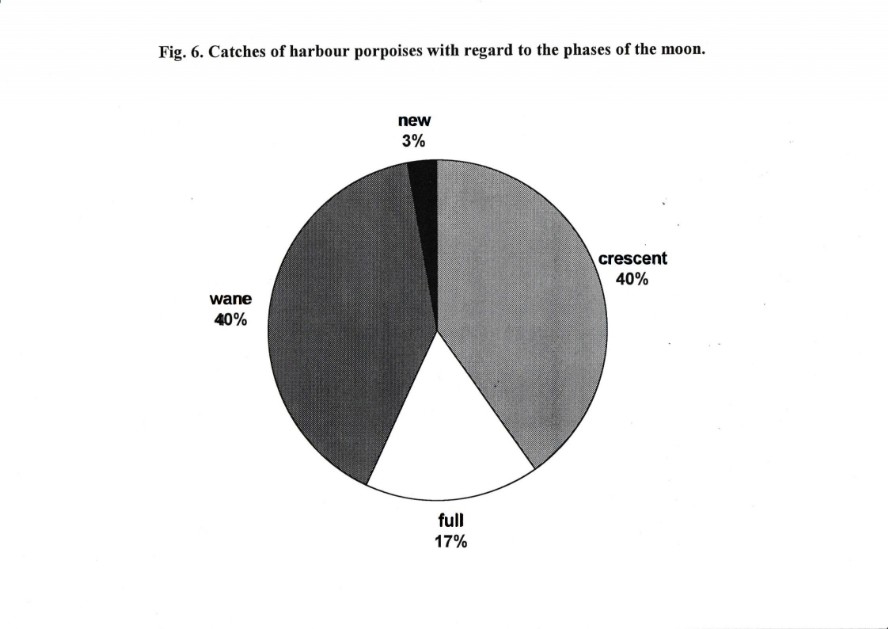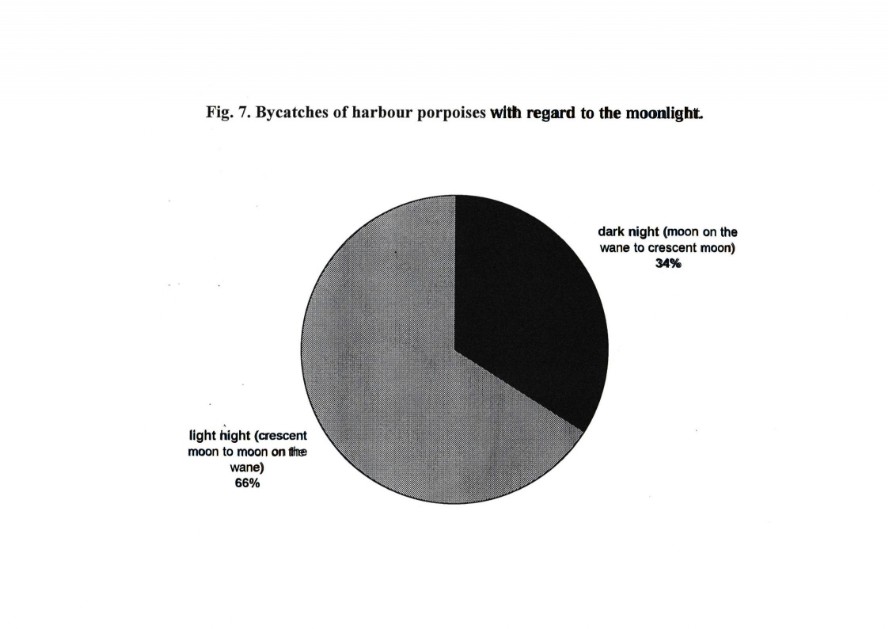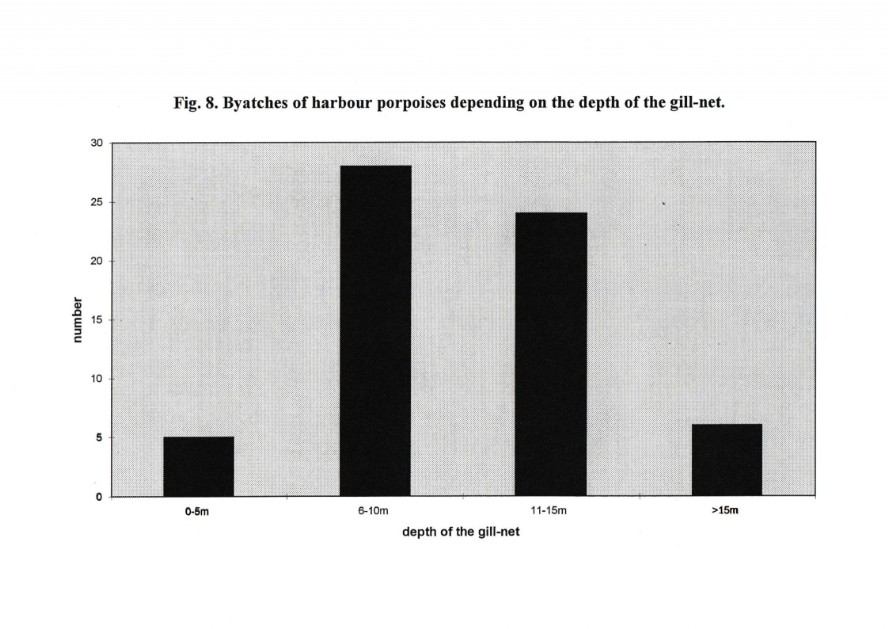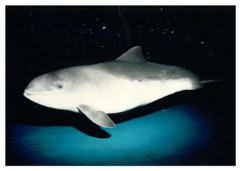Incidental
INCIDENTAL CATCHES AND STRANDINGS OF HARBOUR PORPOISES
(PHOCOENA PHOCOENA LINNAEUS 1758) IN THE COASTAL WATERS OF
ANGELN AND SCHWANSEN, SCHLESWIG-HOLSTEIN, GERMANY, FROM
1987 TO 1996
BORIS PFANDER AND ANDREAS PFANDER
GRUENE STRASSE 13, 24376 KAPPELN/SCHLEI, GERMANY
INTRODUCTION (1)
Harbour porpoises, Phocoena phocoena, have occupied the waters of the Baltic Sea for several thousands of years; fossil and subfossil relicts are found even in the north-eastern part (Kurten 1988). Hunting of harbour porpoises in Danish waters is thought to have begun in prehistoric times (Möhl 1970) but has certainly happened from the middle ages up to the 20th century, which is proved by documents, records and catch-statistics (Klausen 1867, Ropelewski 1957, Petersen 1969). Heavy takes, which sometimes double the catch-level only occured in the last half of the 19th century. This may have lead to an overexploitation and initiated the decline of the stock of harbour porpoises in the Western Baltic Sea, which had “seemingly” not recovered until now (Kinze 1995). The hunting of harbour porpoises in the Baltic Sea has ceased since the end of worldwar II, but still there exist other conflicts with human activities (Schulze 1996). The unintentional capture of harbour porpoises from the German fisheries was first referred to by Alfred Brehm in 1877. Furthermore, Schultz (1970) mentioned the accidental capture of harbour porpoises in fishing nets. At the same time he discribed a reduction of the population in the North and Baltic Sea, however without providing causes or a hypothesis for this decline. Gaskin (1984) saw a threat to harbour porpoises worldwide due to the use of gill nets made of nylon monofilament gear but could not obtain any exact figures for the Baltic Sea, especially for German waters.
The growing concern about the diminishing population of harbour porpoises in both the North and Baltic Sea lead to the international meeting in Bremerhaven, which was held in June 1986 at the Alfred-Wegener-Institut under the title “The Harbour Porpoise in the Baltic and North Sea” (Kröger 1986). On this occasion, Schulze was the only attendee to present data from by-catches, sightings and strandings of harbour porpoises in German waters. His data were summarizing exclusively findings from waters of the former German Democratic Republic (GDR), which has been collected by the Meeresmuseum Stralsund since 1946. One of the first surveys investigating cetaceans in German waters (including harbour porpoises), was conducted by Kremer and Schulze (1990).
Since 1990, two projects with government support have been initiated; their goal was to gather information on population figures, health and migratory patterns, as well as monitoring of small cetaceans in German waters. Various papers have been published documenting the results of these research projects (Kock & Benke 1996, Benke et al., 1998). The research projects also included pathological examinations of the carcasses of harbour porpoises from by-catches and strandings as well as histological, toxicological, bacteriological, parasitological and genetical examinations (Sievert et al. 1999, Kremer 1995, Lick 1991, Bruhn 1997, Tiedemann et al., 1996a, b). Although there are stock size estimates for harbour porpoises in the Western Baltic Sea, which had been gained through areal surveys and the SCANS project in 1994, it could not be determined whether the number of harbour porpoises in this stock were diminishing or not. This current paper supplements and updates information on harbour porpoise by-catches documented by Kock & Benke (1996) for the Western Baltic Sea and takes a closer look at the consequences.
MATERIALS AND METHODS
Between 1987 and 1996 the incidental takes of harbour porpoises have been monitored and documented for a limited area of the Western Baltic Sea. This area extends from the Eckernförder Bucht in the south (54° 27’N) to the Flensburger Förde in the north (54° 53’N) and the waters of Årö (10° 30’E) in the east (Fig. 1).
Fishing is carried out from the ports of Eckernförde, Damp, Maasholm, Kappeln, Arnis, Schleswig, Gelting, Langballig and Wackerballig by approximately 30 professional fishermen an about 50 part-timers. Almost 90% of them use bottom set gill nets, catching flatfish, and herring but mainly cod. Usually the nets were set in the evening and hauled up in the morning, soaktime seldom reaching 12 hours or more. One gill net includes 15 or more segments with a length of 40 meters and comes to a total length between 600 and 800 meters. They are made of fine twine (multi (5) monophyl of 0,1 mm diameter each and have a stretched meshsize between 11 and 12 cm). The distance between the headline and the foodline ropes, which are made of much heavier rope, extends between 120 and 150 cm; but under realistic conditions at the bottom of the sea the position of the net ist seldom vertical and the distance between the two ropes is much less. Due to currents and other circumstances, for instance rocks and irregularities of the bottom, the net is tilted some degrees forming a slope or a bulbous configurations, which is documented by photographs and a videoclip during a dive along side a bottom set gill net.
The cod fishing season is being extended from August to April in the next year. The fishermen`s cooperation is on a voluntary base, since 1991 a revenue is paid for the delivery of the carcass. In contrast to other publications (Moreno 1993) there has been a growing confidence between fishermen, fishery authorities and observers over the years. The respective authorities were advised of all by-catches documented and their circumstances, for example the fishing gear utilized, water deapth, location and weather condition. The by-caught animals were measured, weighed and photographed immediately when possible. Since 1994 blood has been taken directly from the ventricle of recently dead animals in order to carry out specific investigations on toxicology (Bruhn 1997) and blood chemistry. Afterwards the harbour porpoises were handed over to the Institut für Haustierkunde or the Forschungs- und Technologiezentrum Westküste, University of Kiel for further research (Siebert et al. 1994, 1996, Benke et al., 1998, Siebert et al. 1999). Since 1990 stranded animals between the Eckernförder Bight and the Flensburger Förde were also taken into consideration and were intigrated into the research study.
RESULTS
Between January 1987 and December 1996 there have been 74 by-catches of harbour porpoises reported in the before mentioned area (Fig. 1). In four cases the entangled animals could be released from the nets alive, in five other cases the animals were not available for further research due to the fact, that their carcasses fell out of the net as it was being hauled in. The size data given for these harbour porpoises are based on fishermen`s estimations. In another eleven cases the exact location of the by-catch could not be determined, so the port of discharge was given instead. One harbour porpoise had been discarded in February 1991, but unfortunately the exact date of capture could not be given afterwards. Except for three cases, all the reported animals had been entangled in gill-nets. The first exception was an adult male (22), which had been trapped in a trawl net and showed a large infected wound ventrally. One adult female (27) got trapped in a fyke net and another harbour porpoise (29) could successfully be released from a pond net.
From 1990 to 1996 17 harbour porpoises had been washed ashore (Fig. 1). Two of these animals (50 and 87) had recently died, while all others were exhibiting various stages of decomposition. Most of them showed lacervations indicative of fishing net marks, for instance around the head, at the flippers, dorsal fin, tail stock and fluke.
The number of by-catch varied from year to year but has clearly diminished during the period of research (Fig. 2). The highest number of by-catch was documented for 1987 with 16 harbour porpoises, and the lowest in 1995 with two (Fig. 2). The number of harbour porpoises, washed ashore annually appeared to range from two to four, except for 1996, when the number of strandings was even higher than the number of by-catch (Fig. 2).
When it comes to seasonal distribution, the number of by-catch differs (Fig. 3).
Almost 72% of all by-catch occur between August and November, coinciding with the cod fishing season (Fig. 3). The majority of strandings are also reported during the second half of the year, although in July, the number of strandings is higher than the number of by-catch
In order to be consistent with the information presented previously by Kock & Benke (1996) the animals were split into five weight categories and four size categories. This division showed, that most of the sampled animals were of a weight less than 35 kg and a length less than 135 cm (Fig. 4 and 5), which implies, that mainly sub-adults swim into the nets. Considering the sex ratio there ist a slight predominance (54%) of males when compared with females (Fig. 6); however, this is not statistically significant.
On the other hand the fact, that out of 15 stranded animals 13 were male and only two were female seems to be of significance as mentioned later on.
Gill net fishing is almost exclusively carried out during night-time. The gill nets are set in the evening and retrieved in the morning. An investigation of moon phases showed an extremely high proportion of hauls during nights with a full moon (17%, Fig. 7), as the previous report by Kock & Benke (1996) has already suggested. While by-catches during the crescent and convex moon phases were well represented (40 %), only 2 % of the by-catches occured on nights with a new moon (Fig. 7). The relation of dark nights (34 %) to moonlit nights (66 %) shows a clear trend for more by-catch on lighter than on dark nights (Fig. 8).
Figure 10 show the amount of landed fishes during ten seasons (1987 to 1996), based on the official report of the Landesamt für Fischerei, Schleswig-Holstein, for the ports of Flensburg, Kappeln, Langballigau, Maasholm and Schleswig. The landings contained mostly cod (Gadus morhua), herring, (Clupea harengus) and flatfish, (Platichthys flesus, Limanda limanda, Pleuronectes platessa, Solea solea).
The official catch-statistics do not distinguish, which parts of the total amount of landed fishes are from bottom set gill nets or from other fishing activities such as trawles, pond nets, fyke nets and so on. There seems to be some relation between the yearly yield of the fishery and the total number of by-caught harbour porpoises, which should be discussed later on. A descreptive statistic exclusively only from by-catches is given in table 1 to ..
DISCUSSION
The analysis of over ten years of data on by-catch of harbour porpoises in the Western Baltic Sea have drawn the conclusion that by-catch is intrinsically related to the amount of fishing activity. The first evidence for this is the clear seasonal patterns, the months with the highest number of by-catch being at the height of the cod season. Furthermore the decreasing number of by-catch is closely related to the reduction in the fishery quotas (Fig. 2 and Fig. 10). In addition, seasonal migration could be another reason for the reduced number of by-catch between December and March. Following Kinze (1986) by evaluation of 4277 sighting records from 24 Danish ferrylines, migration of harbour porpoises follows the known pattern from historical sources, but the school sizes at present never grows as big as reported from earlier times. Andersen (1982) reported, that a number of animals will overwinter in the inner Danish waters as long as they stay ice free. From our experience we registered by-catches in the warm winters of 86/87, 87/88, 89/90, 91/92 and 94/95 in December and January, but could not distinguish, if this is caused by the behaviour of harbour porpoises or fishing activities favoured by the moderate weather conditions.
The majority of the approximately 75 % of the harbour porpoises incidentally caught during fishing operations were juveniles. This has also been reported by other authors with one possible reason that young animals often swim into the nets while older animals have gained enough experience to know how to avoid getting entangled (Smith et al 1983, Kinze 1990, 1994, Benke et al 1991, Berggren 1994, Gearin et al 1994). There are 3 reasons for this also mentioned in the literature (Kastelein et al. 1995), at first young harbour porpoises start to explore the environment, which is dangerous when these animals encounter fishing nets. Secondly it also seems plausible, that young unexperienced animals do not react echos, which they should perceive as threats. 3. Young animals are usually less cautious and have less precise control over their body movements and, therefore swimming mistakes may occur. This may contribute to a large degree to the entanglement of young harbour porpoises even when they are aware of the danger, the net poses (Dawson 1994, Kastelein 1995). It may be also a question of distance estimation and control of swimming speed, which porpoises gain with experience. For example net experiments performed in a pool with two subadult and unexperienced harbour porpoises showed that the animals, after their first entanglement, learned in the following sessions to avoid this and regarded the nets as a threat (Kastelein 1995).
On the other hand the distribution of stranded animals classified into 2 categories in length and weight (Fig. 4 and 5) seems to mirror the true conditions of age distributions of the stock. Also, the registered cases of harbour porpoises washed ashore will suddenly be in the majority of by-catch, which had been discarded. The clearest indication for this are the typical skin lesions (netmarks) found more or less on the animals as well as a temporal and local distribution of the strandings. Siebert et al (1994) considered netmarks to be the only characteristic of by-catch. Such lesions were found in all carcasses sent in by fishermen and were used to identify stranded animals as suspects of by-catch. However, in stranded animals these lesions cannot always be found, because the carcasses are often too decomposed (Siebert et al 1994). This was the case in 8 carcasses out of 17 strandings in our research; all of the others showed typical skin lesions caused by nets and therefore can be suspected by-catch.
Light plays an important role in harbour porpoise by-catch. There is no other possible explanation for the exceedingly high number of by-catches during full moon and moonlit nights. Also no remarkable tidal current exists in the Baltic Sea, however, it is not yet clear, how the bright moonlight shows it’s effect under water in a depth of 5 to 20 meters (Fig. 9). It is possible that it does have a certain influence on the activities of prey fish. According to Erdmann (1934), Savage et Hodgson (1935), Savage et Hardy (1935) and Schwackenbeck (1935) the yield of the East Anglican herring fishery over ten years between September and December was higher with full moon than in other nights. They found a definite rhythm in the quantities of herrings caught off East Anglia a monthly rhythm with maxima coinciding with the period of full moon and that the best condition for a productive fishery appears to be when the October full moon occurs during the second week. No similar study exists for the Baltic Sea, but out of their own experience fishermen told us, that herring (Clupea harengus Linnaeus 1758) tend to return and congregate in deeper water layers during nights with bright moonlight (also suggested by Erdmann 1934). The same would apply for cod (Gadius morhua Linnaeus 1758), which is feeding on small herring. These two fishes are together with goby (Pomatoschistus sep., Gobius niger Linnaeus 1758), the main prey of harbour porpoises in the Western Baltic Sea following (Lick 1991, Benke et al. 1998). Up to now, we think of a light factor according to the visibility of gill nets, but no scientific examination exists on that theme. It’s uncertain if optical sense is important for detecting gill nets by the harbour porpoises yet. So the theory of Gaskin (1984), that the blinking of the floundering fishes in the nets might attract the animals or the suggestion of Kastelein (1995), based on his experience with net experiments, that the harbour porpoises are been distracted and therefore forget about the presence of the nets, could not been proved.
However, the depth of water is limited in the Baltic Sea, especially in the coastal region of the research area. In contrast to our investigation Read et al. (1990,1997) and Tregenza (1994, 1997) had published data, which show that the accidental capture of harbour porpoises can occur in bottom set gill nets in a depth up to 200 m, but anatomy and physiology of harbour porpoise eyes would allow for optical orientation, as well as hunting and feeding up to this depth of water (Kröger & Schulze1996). Up to now there exists no published data of other areas where harbour porpoises and other small cetaceans are captured in bottom set gill nets in relation to moon phases. An explanation for the fact, that there is more by-catch of harbour porpoises on moonlit than on other nights, could be explained by an increasing effort of the fishery in this phase of moon. But our knowledge, based on interviews with fishermen allows for the statement, that fishing activities depend on weather conditions, depletion of quota and the condition of market and prices more than on moon phases, which has also been suggested by Savage & Hardy (1934).
In the wild a harbour porpoise can survive an entanglement in a bottom set gill net if he is able to swim with the net to the surface to take a breath. This depends on water depth and the physical condition of the individual, as well as the loosemess of the net. Out of our data in four reported cases the water depth was not more than 8 meters and the body length of the animals 120 cm or more. On the other hand this could mean, that harbour porpoises in our research area after their entanglement try to swim upwards to reach the water surface.
From the available data it is not possible, to comment on the population dynamics of harbour porpoises in the research area, although the decreasing number of by-catch could be indicative of a reduction in harbour porpoise numbers. On the other hand the gill net fishery in the Western Baltic Sea had not been introduced before 1971, which was, 16 years before the starting of our research. There are no indications that the number of by-catch has been remarkably higher in the times before. The intensive rate of by-catch in the year 1987, at the beginning of the investigations, seems to have been an extremely high rate (Fig.2)
Through aerial and shipboard surveys in 1994, the final report of SCANS enables an estimation of the number of harbour porpoises to be made with 588 animals in the so called block X, which covers the Bay of Kiel, the Western Baltic Sea and the Little Belt (Hammond et al. 1995), which covers a larger area than the research area. Out of these number about 1 to 3 % of all animals get entangled in bottom set gill nets in the region of our research every year. Assuming that there are fishing activities from other ports as for instance in Kiel, Laboe, Heiligenhafen at the same or larger scale not including the Danish fishery, the percentage would rise even higher. This could mean a real threat for the live stock of harbour porpoises in the Western Baltic Sea, the higher individual risk of juvenile harbour porpoises makes it even worse. There is a need for a more precise estimation of abundance of harbour porpoises at this region and a follow up over the years as well as a close cooperation with fishermen from other ports in the Western Baltic Sea and Danish authorities. The continuation of this present monitoring scheme is merited and in the future additional parameters will be taken into consideration e.g. submergence time of the fishing gear, yield, kinds of fishs, caught and seabed topographie and substrates. A long-term, accurate and statistically confirmed analysis of data would inform us as to whether harbour porpoise by-catch in the Western Baltic Sea is sustainable or not.
LITERATUR:
Andersen, S.H. (1982). Change in the occurrence of the harbour porpoise, Phocoena phocoena, in Danish waters as illustrated by catch statistics from 1834 to 1970. Mammals in the Sea (FAO) 4, 131-133.
Bandomir-Krischak, B. (1993). Anatomishe und histologische Untersuchungen yur Reproduktionsbiologie des Schweinswals (Phocoena phocoena) in deutschen Gewässern. M.Sc. theses. Universitz of Kiel. 90pp.
Benke, H., Kremer, H. and Pfander, A.F. 1991. Incidental catches of harbour porpoises (Phocoena phocoena Linnaeus 1758) in the coastal waters of Angeln and Schwansen (Schleswig-Holstein FRG) from 1987 to 1990. Pp 54-57. In European Research on Cetaceans – 5. Proc. 5th Ann. Conf. ECS, Sandefjord, Norway, 21-23 February 1990 (Ed. P.G.H. Evans). European Cetacean Society, Cambridge, UK. 131pp.
Benke, H., Siebert, U., Lick, R., Bandomir, B. and R. Weiss. (1998). The current status of harbour porpoises (Phocoena phocoena) in German waters. Arch. Fish. Mar. Res. 46 (2).
Berggren, P. (1994). Bycatches of the harbour porpoises (Phocoena phocoena) in the Swedish Skagerrak, Kattegat and Baltic Seas; 1973-1993. In: Gillnets and Cetaceans (Eds. Perrin, W. F., Donovan, G. P. and J. Barlow). Rep. Int. Whal. Commn. 15, Cambridge, 211-215.
Brehm, A. 1877. Die Säugethiere. Band Hufthiere, Seesäugethiere Leipzig Verlag des Bibliographischen Instituts, 691-695.
Bruhn, R. (1997) Chlorierte Schadstoffe in Schweinswalen (Phocoena phocoena): Verteilung, Akkumulation und Metabolismus in Abhängigkeit von der Struktur. Ber. Inst. Meeresk. Christian-Albrechts-Univ. Kiel Nr. 291, 117pp.
Dawson, S. M. (1994). The potential for reducing entanglement of dolphins and porpoises with acoustic modifications to gillnets. In: Gillnets and Cetaceans (Eds. Perrin, W. F., Donovan, G. P. and J. Barlow). Rep. Int. Whal. Commn. 15, Cambridge, 573-578.
Erdmann (1934). Der Einfluß des Mondes auf die ostenglische Heringsfischerei, Der Fischmarkt (Cuxhaven). 12: PP 315-317 (1934).
Gaskin, D. E. (1984). The harbour porpoise Phocoena phocoena (L): Regional populations, status, and information on direct and indirect catches. Rep. Int. Whal. Commn. 34: 569-586.
Gearin, P. J., Melin, S. R., DeLong, R. L., Kajimura, H. and M. A. Johnson. (1994). Harbor porpoise interactions with a Chinook salmon set-net Fishery in Washington State. In: Gillnets and Cetaceans (Eds. Perrin, W. F., Donovan, G. P. and J. Barlow). Rep. Int. Whal. Commn. 15, Cambridge, 427-438.
Hammond, P. S., Benke, H., Berggren, P., Borchers., D. L., Buckland, S. T., Collet, A., Heide-Jørgensen, M.-P., Heimlich-Boran, S., Hiby, A. R., Leopold, M. F. and N. Øien. (1995). Distribution and abundance of the harbour porpoise and other small cetaceans in the North Sea and adjacent waters. Life 92-2/UK/027. Final report to the European Commission, Maz 1995, 242pp.
Heide-Jørgensen, M.-P., Mosbeck, A., Teilmann, J., Benke, H. and W. Schultz. (1992). Harbour porpoise (Phocoena phocoena) densities obtained from aerial survezs north of Fyn and in the Kiel Bight. Ophelia 35: 133-146.
Heide-Jørgensen, M.-P., Teilmann, J., Benke, H. and J. Wulf. (1993). Abundance and distribution of harbour porpoises Phocoena phocoena in selected areas of the western Baltic and the North Sea. Helgol. Meeresunters. 47, 335-346.
Kastelein, R. A., e Haan, D., Staal, C., Nieuwstraten, S. H. and W. C. Verboom (1995). Entanglement of harbour porpoises (Phocoena phocoena) in fishing nets. In: Harbour porpoises: laboratory studies to reduce bycatch (Eds: Nachtigall, P. E., Lien, J., Au, W. W. L. and A. J. Read), De Spil Publishers, Woerden, The Netherlands, 91-156.
Kinze, C. (1986). On the distribution of the harbour porpoise in Danish waters. ICES CM 1986/N: 12.
Kinze, C. (1990). The harbour porpoise (Phocoena phocoena (L.): stock identification and migration patterns in Danish and adjacent waters. PhD. Thesis, University of Copenhagen, 39pp.
Kinze, C. (1994). Incidental catches of harbour porpoises (Phocoena phocoena) in Danish waters, 1986-1989. In: Gillnets and Cetaceans (Eds. Perrin, W. F., Donovan, G. P. and J. Barlow). Rep. Int. Whal. Commn. 15, Cambridge, 183-187.
Kinze, C. Chr. (1995). Exploitation of the harbour porpoise (Phocoena phocoena) in Danish waters: a historical review - Rep. Int. Whal Comm. Special issue. Biology of the Phocoenoids 141 - 153.
Klausen, S. H. (1867). Ved Lillebelt eller Middel fart sund Historie 96 pp (In Danish).
Kock, K.-H. and H. Benke (1996). On the by-catch of harbour porpoise (Phocoena phocoena) in German fisheries in the Baltic and the North Sea. Arch. Fish. Mar. Res. 44 (1/2).
Kremer, H. 1994. Verteilungsmuster der Schwermetalle Blei, Cadmium und Quecksilber in Weich- und Hartgeweben mariner Säugetiere aus deutschen Küstengewässern, Ph.D thesis, Universitz of Kiel, 284pp.
Kremer, H. and G. Schulze. (1990). A review of cetaceans in German waters. Rep. Int. Whal. Commn. Small Cetaceans Com. SC/42/SM26.
Kröger, R. (1986). The decrease of harbour porpoise populations in the Baltic and North Sea. Final report on the Swedish-German Harbour Porpoise Project, 55pp.
Kroeger and Schulze (1996) Kann ich in unserer Datei nicht finden!!!
Kurten, B. (1988). Fossil and subfossil mammals in Finland-Memor. Soc. Fauna Flora Fennica 64: 35 - 39.
Lick, R. (1991). Untersuchungen zu Lebenszyklus (Krebse-Fische-Marine Säuger) und Gefrierresistenz anisakider Nematoden in Nord- und Ostsee. Ber. Inst. Meeresk. Christian-Albrechts-Univ. Kiel 218, 195pp.
Møhl, U. (1970). Fangstdyrene ved danske strande KUML 1970 297 - 329 (In Danish).
Moreno, P. (1993). Interactions of the German fisheries with small cetaceans in the North Sea: a preliminary survey. A report to World Wide Fund for Nature (WWF), 87pp.
Petersen, A. (1969). Marsvin og Marsvinejaegere - Udgiverselskabet Middelfart by - og egnshistoriske museum Middelfart 217 pp (In Danish).
Read, A. J. and D. E. Gaskin. (1990). The effects of incidental catches of harbour porpoises (Phocoena phocoena) in the Bay of Fundy and Gulf of Maine. International Whaling Commission Scientific Committee SC/42/SM21, 18pp.
Read, A. J. (1997). Through the looking glass: the behaviour of harbour porpoises in relation to entanglements in Gill nets. In: Proceedings of the eleventh annual conference of the European Cetacean Society, Stralsund, Germanz, 10-12 March 1997,17p.
Ropelewski, A. (1957). Morswin (Phocoena phocoena L.) jako pzzlow w Polskim rybolowstwie Baltyckim Pr. Morsk Inst Rybackiego Gdyni 9:427 - 37 9:427 - 37 (In Polish) Pr. Mor. Inst. Tedm 9:427 - 434.
Savage, R.E. and Hardy (1935). Phytoplankton and the Herring Part I: 1921 to 1932. Fishery Invetigations of the Ministery of Agriculturs, Food Fisheries London. Ser. 2, BD 14(2) 1935.
Savage, R.E. and Hodgson, W.L. (1935). Lunar Influence on the east anglican Herring Fischery. Journal Du Conseil Permanant International pour L’exploration de la Mer 9(2). Kopenhagen 1934.
Schultz, W. (1970). Über das Vorkommen von Walen in der Nord- und Ostsee (Ord. Cetacea). Zool. Anz. 185 (3/4), 172-264.
Schulze, G. (1986). Information on the situation of research on the harbour porpoise in the GDR. Appendices 2-5. In Report of the International meeting the harbour porpoise in the Baltic Sea and North Sea at the Alfred-Wegener Institute. (Ed. R. Kröger).
Schulze, G. (1996). Die Schweinswale. Die neue Brehm Bücherei Bd. 583 Spektrum Akademischer Verlag Heidelberg. Berlin. Oxford. 191pp.
Siebert, U., Benke, H., Frese, K., Pirro, F. and R. Lick. (1994). Postmortem examination of by-catches from German fisheries and of suspeted by-catches found on the coast of Germany. In: Diagnosis of by-catch in cetaceans: Proceedings of the second ECS workshop on cetacean pathology (Edt: Kuiken, T), Montpellier, France, 2 March 1994, 27-30.
Siebert, U., Lick, R., Weiss, R., Frank, H., Benke, H. and K. Frese. (1996). Post-mortem findings in small cetaceans from German waters of the North and Baltic Sea. Proceedings of the First Scientific Meeting, of the European Association of Zoo and Wildlife Veterinarians (EAZWV), Rostock, Germany, Max 16-18, 1996, 1-8.
Siebert, U., Joiris, C., Holsbeek, L., Benke, H., Failing, K., Frese, K. and E. Petzinger (1999). Potential relation between mercurz concentrations and necropy findings in Cetaceans from German waters of the North and Baltic Sea. Mar. Poll. Bull. 38 (4), 285-295.
Smith, G. J. D., Read, A. J. and D. E. Gaskin. (1983). Incidental catch of harbour porpoises (Phocoena phocoena (L)), in herring wiers in Charlotte county, New Brunswick, Canada. Fish. Bull., US 81 (3), 660-662.
Tiedemann, R., Harder, J., Gmeiner, Chr. and E. Haase. (1996a). Mitochondrial DNA sequence patterns of harbour porpoises (Phocoena phocoena) from the North Sea and the Baltic Sea. Zeitschrift für Säugetierkunde 61, 104-111.
Tiedemann, R., Harder, J. and Chr. Gmeiner. (1996b). Mitochondrial DNA sequence patterns indicate gene flow into the Baltic population of Harbour porpoise (Phocoena phocoena). Verhandlungen der Detuschen Zoologischen Gesellschaft 89.1, 263.
Tregenza, N. (1994). By-catch pathology as seen from the fishing boat. In: Diagnosis of by-catch in cetaceans: Proceedings of the second ECS workshop on cetacean pathology (Edt: Kuiken, T.), Montpellier, France, 2 March 1994, 10-11.
Tregenza, N. (1997). Soll das ein Zitat aus Stralsund sein, wenn ja welches???
